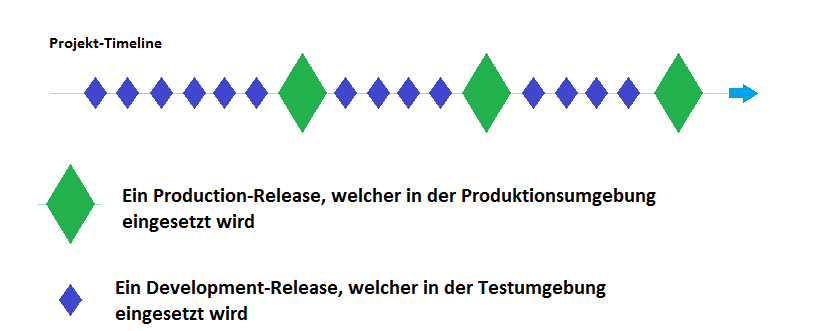Agile Unified Process
The Agile Unified Process ( AUP ) is a hybrid modeling approach that combines the Rational Unified Process (RUP) with agile software development . This was developed by Scott W. Ambler . The AUP offers iterative-incremental access to software development by offering a solid process framework based on the RUP for all types of software projects, in combination with the values, principles and procedures of agile software development. In addition, the following agile techniques are used in the AUP to increase productivity:
- Test Driven Development (TDD)
- Agile Model Driven Development (AMDD)
- Agile change management
- Database refactoring
Work on AUP was stopped by Scott W. Ambler in 2006. In 2009 he started working on the Disciplined Agile Delivery (DAD) framework, in which the AUP is included as a basis.
Philosophies of the AUP
The AUP was built based on the following principles:
- Your staff knows what they 're doing (dt .: Your people know what they are doing ): Read no detailed documentation People, but they want advice at a high level and training from time to time. The AUP provides links to many details, but they are not imposed on any.
- Simplicity: Everything is succinctly described on a few pages.
- Agility: The AUP conforms to the values and principles of the Agile Alliance
- Focus on high-value activities: The focus is on the activities that really matter, rather than all sorts of things that could happen to the project.
- Tool independence: The tools that are used with the AUP are not specified and can therefore be determined by yourself.
- You'll want to tailor this product to meet your own needs (dt .: You will need to customize this product, if possible, so that it meets your needs ): The AUP product can easily with HTML editing tools to be adjusted.
construction
The AUP consists of seven workflows and four phases. The phases are run through once within a project, while the workflows are carried out iteratively. Certain workflows are carried out more or less intensively in certain phases.
Phases
The four phases of the AUP, which are described in more detail below, are the same as those of the RUP :
- Inception (start): The team determines the (initial) scope of the project, a possible architecture and secures the financing and acceptance of the stakeholders.
- Elaboration: The feasibility is ensured and the architecture is finally defined.
- Construction: The software is developed incrementally based on the priorities of the stakeholder (s).
- Transition: The software is validated by the team and used in the production environment.
Workflows
The workflows define the activities that the development team must carry out in order to build, validate and deliver running software that meets the needs of the stakeholders (in brackets at the end of each description the phases in which the individual workflows are relevant are indicated are):
- Model (understanding): The business of the organization should be understood in order to subsequently see the problem in the correct context and to provide a usable solution for this specific problem. (Inception, Elaboration, Construction, Transition)
- Implementation: Models are to be converted into executable code and unit tests of the code created are to be carried out. (Inception, Elaboration, Construction, Transition)
- Test: The aim is to find errors, to validate that the software works as intended, and to verify that the requirements are met. (Elaboration, Construction, Transition)
- Deployment: The delivery of the software should be planned and the implementation of the plan should be carried out. (Construction, Transition)
- Configuration Management: Access to the project artifacts must be regulated. This is not just about recording different versions of the artifacts, rather the individual changes should also be controlled and managed. One reason for this is, for example, that the wrong version of an artifact is not used in the event of any changes. (Inception, Elaboration, Construction, Transition)
- Project Management: Activities that occur during the project must be controlled. This includes managing risks, instructing people (assigning tasks, tracking changes, etc.), and coordinating with people and systems outside of the project to ensure delivery is on time and costs stay within budget. (Inception, Elaboration, Construction, Transition)
- Environment: The rest of the effort must be supported by ensuring that the right process, the right leadership and the right tools (hardware, software) are available to the team. (Inception, Elaboration, Transition)
There are some differences to the RUP here. On the one hand, the work steps Business Modeling, Requirements and Analysis & Design were combined into a model at the AUP. On the other hand, the configuration & change management work step is shown here as configuration management. In agile software development, change management is typically located in the identification of requirements, which can be found under Model in the AUP.
Releases
Instead of the “big bang” process during release, where the entire software is delivered to production at once, the AUP delivers the software in portions (version 1, version 2, ...). Usually, after the end of each iteration, a development release is released into a test environment (pre-production environment), whereby the development release must be something that could potentially be delivered into production. Quality assurance can then be carried out in this test environment before a version with a minimum level of quality can go into production as a so-called production release. This is shown in the following picture on a project timeline:
Individual evidence
- ↑ Edeki, Charles. Agile Unified Process . INTERNATIONAL JOURNAL OF COMPUTER SCIENCE 1.3 (2013)
- ↑ http://www.ambysoft.com/unifiedprocess/agileUP.html
- ↑ Christou, Ioannis, Stavros Ponis, and Eleni Palaiologou. "Using the agile unified process in banking." Software, IEEE 27.3 (2010): 72-79.
- ↑ Van Baelen, Hannes. "Agile (Unified Process)." Book your training with Díaz & Hilterscheid! (2011): 22.
